|
|
Review of GSM-handset Nokia 5300
Live photos of Nokia 5300
Sales package:
- Nokia 5300 XpressMusic
- Nokia Battery BL-5B
- Nokia Stereo Headset HS-47
- Universal headphone adapter
- microSD card (size varies by region – for Russia it is 256 Mb)
- CD-ROM
Over its entire history Nokia has been trying to come up with successful youth-aimed devices, armed with MP3-player, though these attempts lacked any kind of systematic character and on top of that didn’t received appropriate marketing backup. Early in 2002 the market saw the release of Nokia 5510, standing out owing to landscape layout of controls and bundled music player. However being a bulky and strangely designed device, the 5510 didn’t hit the charts’ top. In summer of 2003 the company launched the successor to the first attempt in this field – Nokia 3300, which boasted the same form-factor, but got amplified with radio module. Back then the manufacturer didn’t succeed in planning – the device didn’t manage to become a bestseller, on the contrary, the 3300’s sales kept on being somewhere between slim and nil for 1,5 years after the release. It’s remarkable that the first product placement scenes in a couple of movies appeared a year after the solution’s introduction, which is all another way of saying this model was mostly a failure.

Lack of success with these two products had discouraged Nokia from establishing such range until 2005, when XpressMusic stepped into the limelight. This brand had eventually become a must for most S60-based smartphones’ press-releases, even though their music capabilities as a rule had nothing to shout about. That is how come consumers could not figure out what the exact differences from the other models were, while the manufacturer himself seemingly aimed at leaving out music-optimized features of one or another handset. Against the background of prime sales of Sony Ericsson’s very own Walkman-branded phones, the advent of XpressMusic brand turned out to be just a formal strike-back, since no real steps were undertaken by Nokia. Nevertheless ever-growing rates of Walkman popularity in the end have forced Nokia to turn its sight to the market of music-tailored handsets and revise its very strategy and behavior there.
Nokia came to its senses at last, and has been intensively developing XPressMusic line-up for both S40- and S60-based products during the last six months. S40 platform has undergone some serious changes, as the company has applied different ways of positioning and enhanced its overall functionality. Let us take a view of what the company has already done and what the market should expect in future.
The list of improvements looks quite impressive indeed, here are the primary aspects:
- Orientation towards embedding standard miniUSB socket in all XPressMusic-labeled phones – this cuts down expenses on purchases of extra cable and standardizes the interface itself.
- Availability of a PC application for converting songs, into AAC format as well (MP3-quality a size smaller by 20-30 percent), which is shipped with PC Suite software kit.
- Re-worked player’s interface includes logical layout of controls, refreshed set of equalizers, music library similar to that found on S60-powered devices (a pack of genre, artist etc. filters)
- Support for A2DP Bluetooth has become a must for all products, which allows using wireless stereo-headsets (the only exceptions are old solutions that have already been up for a while, for example S60-based smartphones like Nokia 3250).
- Presence of 2.5 mm jack on S40-based phones’ casings (allows for plugging in corresponding earphones) and an adapted for connecting 3.5 mm earphones via that jack. Some models will initially carry a 3.5 mm jack on them. All in all, a devastating move, especially when taking account of Sony Ericsson refusing to incorporate standard jacks into mass Walkman models (plugging in of own earphones via a headset).
- Dedicated music player keys on most devices running on the S40 – a riposte to Walkman series that traditionally make use of doubling keys.
- Positioning of XPressMusic-branded devices as music-centric solutions, and thus setting up of competition with Walkman line-up.
Some innovations appear to be piercing steps against Walkman brand (miniUSB-socket, side-mounted keys, and brand promotion), however there is nothing fundamentally new in them, as Walkman has already undergone all these measures in one or another way. Having gathered a critical number of followers, Walkman acts as a leading music solution, thus Nokia ends up playing an unusual role of a runner-up. But the brand-new XpressMusic line-up seemingly can cope with such goal, especially considering the weight the world’s best manufacturer (according to consumers) has got. Nokia is bending every effort to development of XPressMusic series, so basically the announcements of September, 27 are only the first signs, as in the next six months we are going to see 5-6 more devices originating from this series, while their functionality will start growing gradually. For the time being, we can say that the new models running on XpressMusic and Walkman 1.0 respectively (version 2.0 proposes greater capabilities) are almost equally good.
Another crucial point here is marketing support of music handsets coming from XpressMusic range – it’s the first time when manufacturer comes up with a well-shaped offering, so that consumers readily grasp the differences from ordinary devices (should grasp, to be precise). Though, certain mess has been brought about with the necessity to launch numerous products simultaneously – from now on the Nseries line-up contains many models with Music Edition suffix that makes them differ from the predecessors mainly in casing’s trim and sales package, while sound quality has been left unchanged. The next tricky thing is release of branch XpressMusic-related solutions, like Nokia 5200 – Nokia 5300 duo. The junior device is by no means a music-optimized one, although it retains the same music player, earphones and looks of Nokia 5300. Naturally, such merging of ranges might greatly confuse consumers; therefore the company should consider separating music solutions and ordinary handsets in a more obvious manner. There is no way of getting all goals reached with all-in-one products alone, as today Nokia’s propositions are mainly do-it-all ones – what they lack is specialization.


Shortcomings of XpressMusic-branded devices include the indexing system, made use of by Nokia – the main information is revealed in a model’s number, while there is no alphabetic code in it. For example, within the Walkman range, all models carry “W” letter, which in one or another visual way appears in advertising campaigns and then gets mounted on device’s casing. In its turn, Nokia simply has not yet come up with a logo that would clearly say “it is XpressMusic”, however it makes sense to assume that it will get introduced early in 2007. At any rate it would do much help to devices positioning - XpressMusic suffix looks quite ponderous, thus not all consumers are going to pay much attention to it.
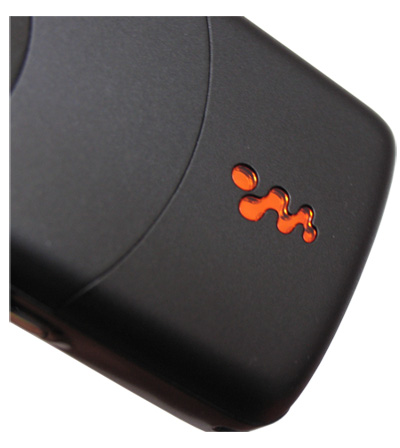
In many respects launch of Nokia 5300 is a momentous event, as this is the first mid-end device living up to the title of a music-optimized solution and on top of that- the S40’s first XpressMusic offspring. The choice of form-factor for the 5300 has been pre-defined by Sony Ericsson’s efforts – there were times Walkman-branded phones packed all their features only into candy-bar shaped shell, a little bit later clamshells started getting “W” letters as well, and only now the market sees the release of a slider - Sony Ericsson W850i. Over at Sony Ericsson, they attribute sliding casing to top-notch solution and keeping that in mind, they implemented it into Walkman range flagship (in fact there are two of them – the W850i and the W950i). Launch of an identically-formed handset by Nokia is a well-planned riposte, especially considering lower price of Nokia’s solutions; generally speaking, these are phones of two different price-brackets, but similar type. Thus a certain part of the audience might go for Nokia’s slider in view of price advantage and proper positioning.




Aim at youth has made the casing retain white framings, which makes the phone well-recognized. The 5300 comes only in two trims – red and dark-grey. In both cases it is only the middle part that differs, since it houses a “tape” of a certain color, while the bottom and the top rims remain white. Utility of white color raises doubts at first, but eventually it proves to be dirty-resistant, which cannot be said about the painted framing. While for the grey finishing this issue is not too crucial, the red color scheme is a finger prints magnet. Unlike the matt white plastic, the casing is made of, the central part is slightly rubberize – already after three days of use the pads mounted on the back panel got dark. The dedicated player keys are not exposed to soiling, though on closer examination their color differs a little from what was in the beginning. On intensive use, the casing gets soiled in no time – dirt becomes well-visible. However there is good news as well – the 5300 will look fine should you wipe it with a wet piece of cloth.
The handset’s design is quite appealing, although it instantly reveals youth-aimed concept in it; the 5300’s outlook is somewhat similar to the style applied to Alcatel’s solutions, in other words it appears to be out of place in Nokia’s very own range. The phone will definitely not fit consumers other than young people – the manufacturer itself emphasizes that with everything he has got. Apparently, more austere curves and shapes, unlike those of Cosmo, will be positioned higher than this phone, after all it’s only the first product of this kind.
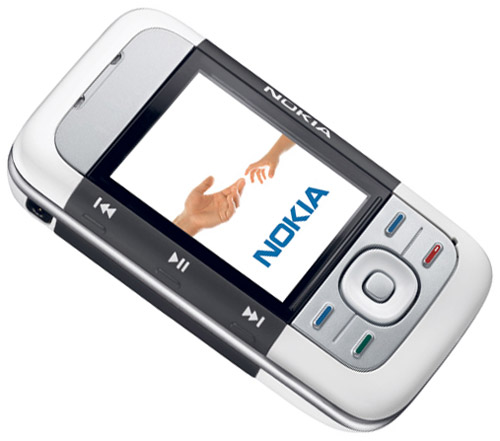
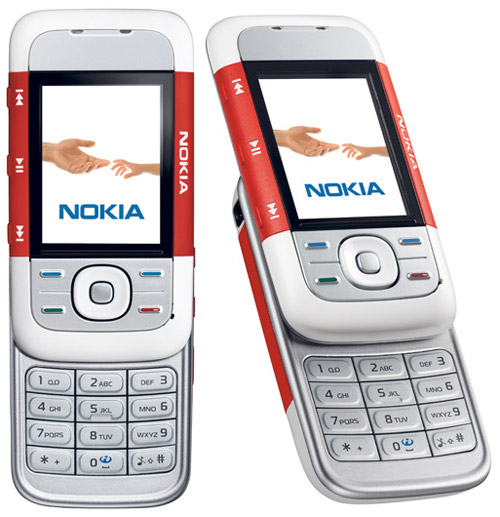
Location of Nokia’s label on the casing grabs attention as well, as now it is placed vertically on the right. The explanation lies in the fact that many modes here require landscape orientation (camera mode, for example) – player shortcut buttons on the left edge strengthen this point of view. Regrettable, the manufacturers didn’t enable any applications other than the camera to switch the display into landscape mode.
The dedicated player keys are quite bulky and thus well-visible, so that one could manage them even being blind. The right side houses volume shortcut keys and also the camera button, which are positioned more towards the bottom rim, although this doesn’t affect overall ease of use. Owing to all keys being rubberized and sticking out of the surface, it’s not always convenient enough to press them, as you always need to place your finger with due precision. On the other hand, in day-to-day activities, that doesn’t make all the difference – you just keep pushing the buttons without thinking too much about such things.


The handsets measures 92x48x21 mm in size, which quite typical for sliders of this type. The 5300’s weight makes 106 grams, therefore having it hanging around your neck doesn’t cause any inconvenience.
Video, comparison of dimensions, spring mechanism and more (wmv, 24.2 Mb)>>>



The model boasts a QVGA screen (240x320 pixels, 31x42 mm), capable of displaying up to 262 K colors (TFT). All in all the 5300’s display does quite well and provides fair color depth and vivid picture. In the sense of picture quality, it somewhat reminds of that found on Nokia 6233, but yields to Nokia 6131’s screen. For the class Nokia 5300 comes from, the display performs on acceptable level. Even though it fades in the sun, information doesn’t slip away. Depending on picked font size and active application, the display can house up to 9 text lines (there may be more) and up to 3 service lines.

Two soft-keys are mounted beneath the screen; the four-way navigation key incorporates OK key – this button exposes considerable gaps, which might get filled up with dust in time, but I doubt it will cause much of a problem. Next to the right key one will find the microphone’s hole – as a matter of fact, it is placed there to allows answering a call without sliding the 5300 open.
Video, outlooks of the handset, headset and adapter (wmv, 14.2 Mb)>>>

An amusing thing about the handset’s looks is the silver hairline found on the hang up key (on the right) – briefly speaking, its color matches the one applied to the navi-pad, so that at first I had a strong desire to brush off a “sticky speck”, which is in fact the hairline. In time I have gotten used to that, but why the manufacturer would need to ruin the symmetry and not mount the same hairline on the left, is obscure.

The slider is armed with auto-spring mechanism, which means it is really easy to slide open. Beneath the screen you will find a tiny thumb rest, however due to minor height your thumb will keep hitting the display’s lower rim. Nevertheless such touches leave almost not traces.

The keypad is moderate size-wise, with all the plastic buttons singled out. The buttons offer average easy of use, in other words, you won’t find neither groundbreaking advantages, nor frustrating flaws here. The keypad is lit in blue, which makes it well-visible in various environments.



The left side houses 2.5 mm audio jack, compatible with 3.5 mm adapter shipped with the handset. On the right you will find Infrared window.


The manufacturer has deliberately dropped out Pop-Port in favor of standard miniUSB socket, found on the top rim. Right here you will find slot for charger (the tiny one), power button and holes for a carrying strap.


The back panel is packed with various details, including 1.3 Mpix CMOS-powered camera module, self-portrait mirror and loudspeaker’s grill. The battery cover sits in the slot pretty tight owing to the latch. Removing the cover requires certain strain and reveals the battery module. The 5300 makes use of a 860 mAh Li-Ion battery (the BL-5B). As the manufacturer claims, it can power the handset for 3 hours in talk mode, up to 223 hours in standby mode and around 12 hours in music playback mode.

In conditions of Moscow networks the devices lasted 3 days on the lowest possible use of its functions (20 minutes of calls, a few hours of music playback, a couple of SMS messages). Though when we got heavier on its connectivity and music capabilities, the lifetime went down to 2 days (1.5 hours of calls, up to 4 hours of music playback). Music player with maximum sound volume, default headset and random playback (tracks were stored on memory card) enabled, the 5300 provided 9 hours of lifetime, whereas Walkman-branded devices put on up to 25 hours of music playback in similar conditions. The manufacturer doesn’t offer batteries with extended capacity for this model. It takes Nokia 5300 about 3 hours to charge from empty to full.

The SIM-card's slot appears to be quite usual – the holder should be opened before you can extract it.

Menu
We are not going to speak about default handset’s features, such as phonebook, organizer etc. here, since they are pretty much the same for all S40 3rd edition-based devices and on top of that, have already been covered in great detail on Mobile-Review.
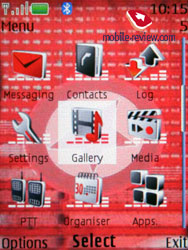 
What we would like to dwell on now is Nokia 5300’s distinctions from the previous models and what impact these changes have on the device’s ease of use. The 5300 comes in two modifications – the RM-146 and the RM-147 – the latter one got the index of the 5300b (which handles 850 Mhz instead of 900 Mhz – that’s the only difference, while other bands, 1800 and 1900 have been left untouched). As you might have already guessed the model with “b” letter in its index is meant for the American markets.
Unfortunately, over at Nokia they are getting to pay less attention to what a device runs on – on the release of Nokia 5300 no one could answer an unsophisticated question: which version of the S40 is incorporated into the model – Feature Pack 1 or “pure” S40? I would have readily accepted that if Nokia’s representatives had been just tricking journalists, but those people in charge for software development honestly did not know the answer. Furthermore, on closer examination of Nokia’s guide it turned out that over at the company they didn’t realize themselves what Feature Pack1 for S40 3d Edition was, and where to get somewhat credible documents with change logs that could be relied on. It does sound like ravings of a madman. But regrettably it is so – those who sell phones can’t list all the advantages of their proposals, while the developers have been quarantined from the rest of the world and more importantly, their colleagues.
At Nokia’s wonderful resource for developers, they say that Nokia 5300 runs on 3rd edition enhanced with Feature Pack 1, which makes some sense. However the same refers to Nokia 6131 and several other models, which brings about even more mess – what one should consider to be Feature Pack1 and is there any way to tell the difference between these devices? For lack of the desire on Nokia’s side to release such information, we carried out some face-off on our own and found out the major differences (Nokia 5300 and Nokia 6233/Nokia 6131 were picked for that). We might have missed something, but on the whole, as we suppose, we managed to come up with a decent list of changes that includes both hardware- and software-related distinctions. Without any further ados, here is the list of what Feature Pack 1 brings into S40 3rd edition according to Mobile-Review.
- Completely revamped music player, new interface, support for music library, tracks sorting.
- Support for Flash Lite 2 instead of version 1.1 found on the previous handsets.
- Possibility to set flash-clips as wallpapers or screensavers.
- OMA DRM 2.0 instead of version 1.0 found on the previous handsets.
- A2DP-profile for Bluetooth, allowing for use of wireless headsets
- Possibility to set any file via the handset’s menu as Call back-tune (requires operator’s support).
- Introduction of Security and Trust Services API (JSR-177) for Java.
- Background mode for all music-related applications (player, radio).
- miniUSB socket.
Should you have any information on what features are brought about by Feature Pack 1 as against the previous edition – please, share it with us, we will greatly appreciate that.
Many of the abovementioned alterations are to be attributed to the hardware ones and might be encountered on older models to one or another extent. For example Nokia 6280 acquired A2DP support with firmware version 5.92. But speaking about Feature Pack1 we look at the entire set of changes rather than stand-alone functions.
USB. The handset comes included with DKE-2 cable, which can be easily replaced with any miniUSB-cable. On connection to PC you are at liberty to take advantage of any of these three modes:
- Nokia Mode – formerly known as PC Suite, allows synchronization with Nokia’s application of the same name. This very mode also enables you to use the handset as a modem.
- Printing and Media – the handset switches to MTP protocol, which allows uploading from PC new albums with the help of Windows Media Player and default Windows XP’s tools.
- Data Storage. Standard USB Mass Storage mode, device is identified by PC without asking you to install extra drivers.
During USB-connection the 5300 does not recharge itself, and should you leave it connected for a while, be ready to see an empty battery in 6-7 hours. Data transfer speed makes about 950 Kb/s (USB 2.0), which is quite good for a handset, but at the same time somewhat insufficient for a music-optimized device.
Bluetooth. The handset retains EDR-enabled Bluetooth 2.0 with the following profiles supported:
- Headset;
- Dial Up Networking;
- Object Push;
- File Transfer;
- Hands-Free v1.5;
- A2DP;
- SIM Access.
Bluetooth found in the 5300 puts on acceptable performance and will hardly give you a hard time.
Music player. The main thing Nokia 5300 is made for is music playback, thus we obviously are to review music player’s capabilities in greater details. The manufacturer based the actual solution on the developments of Nokia N91 and set out to be on a part with Walkman’s first generation, since these devices had already become a bar for the industry. Taking account of significant experience of other companies, had collected in course of several years and also own solutions, the company made an attempt to get S40-powered device and XpressMusic going along in a basic device. In other words, it is not something out of this world, but rather a reasonably feature-packed model already.
Video, music features of the device (wmv, 31.75 Mb)>>>
 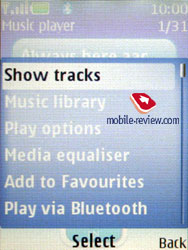
 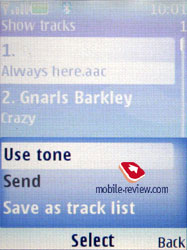
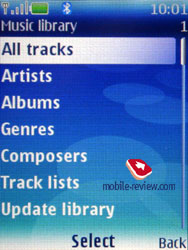 
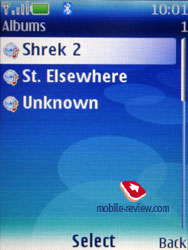 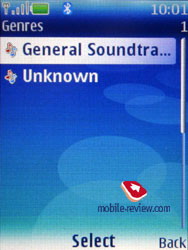
 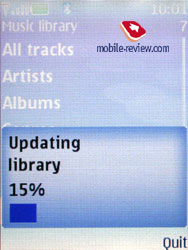
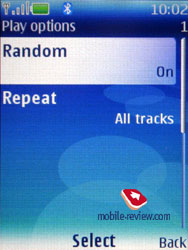 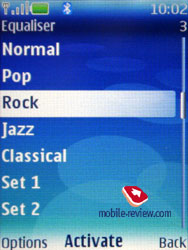
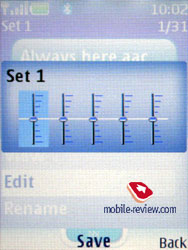 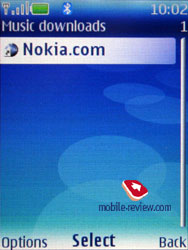
Similarly to the radio, the music player found on the 5300 can be minimized, at that no application that can affect that – you can run any Java-app, for example JIMM, at the same time as well. Last used application is only one click away with the side key – if it was the music player, playback starts right from the place where it stopped; in case of radio, the handset turns on the station you were listening to. But pay attention to the fact that this button cannot be customized. Should you press the key while navigation through menus, playback will start in background mode. When you are at the phone’s standby screen, the player displays track’s title and artist on the screen.

The player’s looks is quite smooth, even though custom skins are disabled for the time being. The display offers information on current track, album and artist. The navigation pad is bound up with standard functions (track switch, rewind, and stop). Progressive rewind feature is missing on the 5300 – you can fast-forward tracks at standard 5 sec. pitch, which is completely out of use with big files (audio-books or something like that).
Playback may be random or sequential, Repeat mode works for both all tracks and individual files.
Outside the player’s application you will find Stereo Widening feature, which is, frankly speaking, pretty crude, while equalizers do have an impact on sounding quality. There are five presets (Normal, Pop, Rock, Jazz, Classical) for the five-band equalizer found on the 5300, and two user-customizable ones.
The music library contains the following filter tabs:
- All tracks – all files stored on the handset
- Artists – all tracks of certain artists
- Albums – arranges all tracks by albums.
- Genres – filters files by genres, like classic, rock etc.
- Composers – filters tracks by composers.
- Track lists – Another set of filters, including Favorites (where any track during playback or choosing may be added to), Most Played Tracks, Recent Tracks, Recent additions and My Track lists. On the whole, it’s a really credible filter that might prove useful for some.
Playlists may be composed both on PC and on handset; however the 5300’s set of tools for playlists creation is far from perfection – you just choose a track from the general list and save it as Track List. No extra files can be added to this list, no matter how hard you try – we failed to find such feature. Furthermore, such lists aren’t marked in the media player, which is a serious flaw. Winding the story up, we would recommend the developers to keep on getting this function better.
Music downloads is a stand-alone menu item, featuring only a like to Nokia’s site – after launch of the service Nokia Recommendation will lead there.
The bundled stereo-headset HS-47 houses pick up key and two bud-shaped earphones edged with rubber strings, the sales package also includes two ear bud soft cover sets (black and red). The headset makes use of 2.5 mm jack, which means it connects to the 5300 directly.




As far as I remember only Nokia N91’s default headset could output fairly admirable sound quality, whereas other devices, even positioned as music-optimized solutions, were shipped with headsets that left much to be desired. Regrettably, the same goes for Nokia 5300, although it sounds ridiculous to save coin on a music handset’s earphones, since here everything comes down to sounding. With the default headset plugged in, the 5300 stays far and far behind Walkman series – music is simply non-penetrating, basses are too quiet, in a nutshell the quality of headset is lower than average. However everything turns upside down, when Walkman’s headphones get connected to Nokia 5300 – sound turns out to be pretty clear, while overall volume is slightly higher with Nokia 5300.
But thankfully, the company included into the sales package AD-50 adapter, allowing for use of standard 3.5 mm jack, hence you can just plug in own earphones and enjoy completely different level of sounding, which proves to be on a par with Walkman 1G. Due to missing Pop-Port on the 5300, there is no way you can make use of a remote control for the handset.
Support for A2DP profile on Nokia-branded phones is uncommon at present, which only doubles our please to discover it on the 5300. To try it out, we picked two headsets: Nokia HS-12W and Sony Ericsson HBH-DS970. In both cases pairing didn’t cause any issues – sound was being transferred to headsets outright. Nevertheless the DS970’s sound quality was superior to that of Nokia’s product owing to better speakers, thus the rest of our tests involved the Sony Ericsson’s device alone. When running A2DP protocol, your handset compresses file on sending, while headset decompresses it and plays back. Basically, the compression algorithm is what everything is all about here, as the manufacturer has to attune it in a way that would allows including the required information and prevent jamming (music stored on memory cards may be delayed a little, while radio won’t go with that). However, I should make a note that radio broadcasts cannot be transferred to Bluetooth-headset with Nokia 5300.
For a small face-off we took Sony Ericsson W850i and played back one and the same track with the DS970 in order to rate sound quality. Eventually, everyone agreed that Nokia’s performance is somewhat worse (at comparable volume) – the 5300 occasionally cuts out basses and lower frequencies. The difference between the handsets doesn’t need to be proven with special tests, basically, anyone can hear it, which is especially disappointing, considering comparable sound quality generated by these two phones in wired headsets. Another shortcoming of Nokia 5300 is the necessity to position both the handset and the headset in a proper way – sound interruptions start popping up if you carry the phone in a bag or running (so that the bag starts reeling). Sony Ericsson’s devices lack such drawback.
Music Manager application, included into Nokia PC Suite offers only two option when it comes to uploading files on a handset: convert into AAC or eAAC+. What such strict limitations are for is unclear – it might seem that Apple’s success is bothering someone. The best way to share music with a handset is using MTP protocol or copying files to the device directly. But what is more frustrating, is the fact that the first version Nokia Music Manager fails in recognizing ID3-tages correctly, and as a result all the filters found on the 5300 move straightly to “Useless” category (only tracks’ titles remain untouched). For Russian language, one will find support only for Unicode tags, which is the issue of the day for all music phones for the time being.
The bundled 256 Mb memory card doesn’t enable you to store acceptable number of tracks on it, so that replacing it with a more capable one would make more sense. Today Nokia recommends (for the sales package) memory cards with 512 Mb onboard for most markets – as for me, it would be reasonable two year ago on release of Walkman-branded devices, since today the least credible volume of memory card is 1 Gb. Therefore, the manufacturer could just cut down the solution’s price by shipping only 64 Mb card with it. Nokia is not at liberty to leave out a default memory card at all, in light of the fact the 5300 carries only 7 Mb onboard, thus a memory card serves as storage for pre-installed applications, themes, wallpapers.
As a matter of fact we have pretty good sounding, obvious enhancement of interface layout and presence of dedicated keys with the 5300. All this acts in Nokia 5300’s favor and puts it on the same line with first generation of Walkman handsets. The music player found on Nokia’s solution supports WMA format apart from AAC, eAAC, eAAC+, MP3.
What features are going to be incorporated into XpressMusic player in the future? Let us call it “second edition” scheduled for the release in the middle of 2007:
- Progressive rewind (FW update, Q2).
- Track search by name.
- Transferring of ID3-tags to external headset (improved compatibility with Jabra, SE).
- Enhanced compatibility with Nokia Music Manager (preservation of tags after conversion).
- Support for various shells and skins.
- More scales on volume control bar.
At the same time, differences between Nokia’s products and Walkman range are of some interest as well. Here is a short list of distinctions:
- While sound quality is comparable, Walkman’s default earphones perform better.
- No way to use a remote control, like that available for Walkman device, for example the HPM-82.
- While volume of memory cards is comparable, price for Sony M2 is higher by 20-30 percent, though sales packages feature bigger memory cards.
- Implementation of A2DP-profile is superior on Sony Ericsson-branded phones.
- Availability of progressive rewind.
- More customizable equalizers.
- Better playlists management.
- Disc2Phone for PC allows converting tracks into MP3-format at various bitrate, move flexible settings
- Support forAlbum Arts (Walkman 2.0).
- Music recognition feature (TrackID for Walkman 2.0).
Camera. The handset houses a 1.3 Mpix camera, which is quite incapable in light of the nowadays criteria, but still enough for a model coming from the mid segment. Despite the proposals, already armed with 2 Mpix camera modules, the 5300 is not a camera-centric phone and therefore carries one of the cheapest solutions, providing fairly poor quality. In the sense of camera the brand-new 5300 acts exactly in the same way as Nokia 6131, but owing to updated software, shots look slightly better, though no groundbreaking changes have been introduced. The camera application works in landscape mode, which makes it more convenient to handle, even though finger always tries to cover the lens – but it’s a thing you get used to in no time.
The following resolutions are supported:
- 1280x1024;
- 1280x960;
- 800x600;
- 640x480;
- 320x240;
- 160x120.
The last two minimal resolutions were added in order to allow taking snaps for wallpapers for internal and external display respectively. There are 3 JPEG compression types supported: default, normal, high. Since the quality leaves much to be desired in any case, better set compression to high – it won’t make the photos any worse.
Shutter sound may be turned off, the camera is equipped with a digital 8x zoom, though I wouldn’t recommend using it. You can choose the place to store all photos in – this may be either the phone’s memory or a memory card.
The effects may be laid onto taken photos – does applying them beforehand make sense, it’s up to you to decide. The following effects are available: False colours, Greyscale, Sepia, Negative, Solarise.
When shooting indoors, the matrix exposes lack of sensitivity outright – darker objects get blurred with green stains, this goes especially for backgrounds. Turning the night mode on saves the day, yet the colors get dim – check this out on images with the glass of juice and the chair hack.
For those, keen on multi-shooting, the camera offers a special mode, which enables you to take 3 pictures at a time. All settings are copied from the ones for single-shooting, including resolution. This is a time for self-shooting, however due to the fact the camera starts up when the handset is closed (the outer display doubles as a viewfinder), it won’t be very helpful.
Below you will find snaps taken in various environments – I guess no further comments are required, as you can make a conclusion on your own (maximum resolution, best quality).
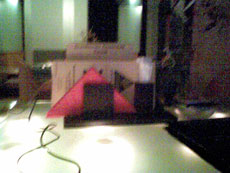 |
 |
(+)
maximize, 1280x1024, JPEG |
(+)
maximize, 1280x1024, JPEG |
 |
 |
(+)
maximize, 1280x1024, JPEG |
(+)
maximize, 1280x1024, JPEG |
 |
 |
(+)
maximize, 1280x1024, JPEG |
(+)
maximize, 1280x1024, JPEG |
 |
 |
(+)
maximize, 1280x1024, JPEG |
(+)
maximize, 1280x1024, JPEG |
 |
 |
(+)
maximize, 1280x1024, JPEG |
(+)
maximize, 1280x1024, JPEG |
 |
 |
(+)
maximize, 1280x1024, JPEG |
(+)
maximize, 1280x1024, JPEG |
 |
 |
(+)
maximize, 1280x1024, JPEG |
(+)
maximize, 1280x1024, JPEG |
 |
 |
(+)
maximize, 1280x1024, JPEG |
(+)
maximize, 1280x1024, JPEG |
 |
 |
(+)
maximize, 1280x1024, JPEG |
(+)
maximize, 1280x1024, JPEG |
 |
 |
(+)
maximize, 1280x1024, JPEG |
(+)
maximize, 1280x1024, JPEG |
 |
 |
(+)
maximize, 1280x1024, JPEG |
(+)
maximize, 1280x1024, JPEG |
Video. The handset is capable of capturing video in 3GP extension with the resolution of 128x96 or 176x144 pixels. Quality has three grades like single shots. Though the maximum duration of a single clip may be limited, it’s possible to go on recording until you have no free memory left. The quality is quite mediocre; it would have been strange to receive something different with such camera. All effects may be applied to video clips in the same way as to photos, their numbers totally coincide.
Video sample 1 (High, 176ő144 pixels, 3gp, 540 Kb)>>>
Video sample 2 (High, 176ő144 pixels, 3gp, 42 Kb)>>>
Video sample 3 (High, 176ő144 pixels, 3gp, 328 Kb)>>>
Pre-installed applications
The handset offers three games - Snake III (3D), Pro Snowboard (3D, adopted from Sony Ericsson’s phones released in 2004) and Music Guess, which is a truly music-aimed application – the program picks random tracks out of the general list and during playback you need to guess what song is playing.
 
 
The applications are: World Time, Nokia Sensor (excellent offering for the youth, which is not so popular at the moment in light of the fact only a few devices have this function, yet it has great potential). The last application on the list is Converter II. The handset also boasts a pretty-looking flash-clip giving you an idea of Nokia 5300’s main features.
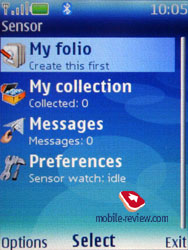 
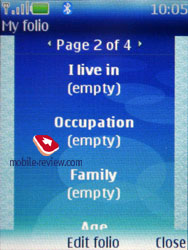 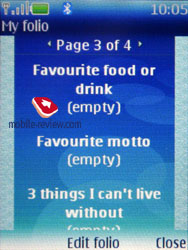
Impressions
The volume of 64-tone polyphony is enough for almost any conditions. The receiving part also does fine, as it equals all other phones of the current generation. The silent alarm is average strength-wise, but can be still felt while the handset is in pocket.
It’s remarkable that for the first time in a commercial solution Nokia changed title of applied technology – in call settings menu you will find Voice Clarity item that is associated with majority of Samsung-branded products. In short, it’s a kind of equalizer, reducing interference to the nil, which makes voice sound clearer even in the most sound-unfriendly environments. This feature started appearing on Nokia’s handsets after it had been publicly announced by a company going by the name of Voice Clarity. Originally, it bore “sound enhancement” title in Nokia’s offerings. Why would they need to use a new wrapping for old technology is somewhat obsure.
On the release, scheduled for October, price for Nokia 5300 will make 265-270 Euro. It will be strongly opposed by Nokia 5200, showing off resembling design and having the price lower by 50 Euro at fewer dedicated player buttons and missing XPressMusic suffix. At the same time these handsets are identical player-wise, although the junior device offer worse display and lacks a memory card in its sales package. Nevertheless the worst shortcoming is screen, while all others are not that crucial. In opinion of unsophisticated consumers, Nokia 5200 and Nokia 5300 will look almost alike. Generally speaking it is what the marketologists have been aiming at – coming up with duos.
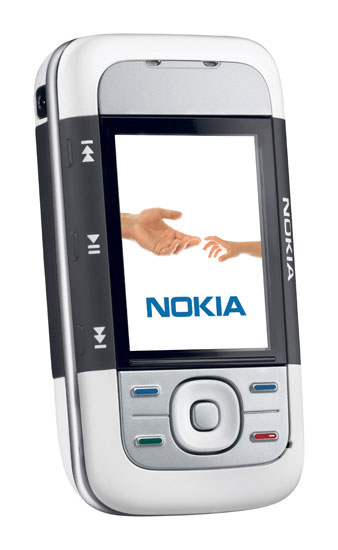

However the market is not experiencing lack of music handsets produced by a direct rival of XPressMusic range – Walkman line-up. The folding phone Sony Ericsson W300i appears to be the most serious competitor for the 5300, as it comes included with 256 Mb memory card as well, but carries a VGA camera, inferior screen and cannot boast support for A2DP profile. At the price of 200-220 Euro (varies by region), the difference of 50-60 Euro is not the thing to be overlooked – eventually these products end up in different price-brackets. In the sense of music capabilities they are pretty much the same, which may be considered as Nokia’s achievement in this field. The more traditional form-factor brings such solutions as Sony Ericsson W700i/W800i that don’t have much to do with the reviewed model, though. In the top price-bracket Sony Ericsson has a lot of proposals that significantly differ from the 5300 price-wise and thus cannot be attributed to the group of Nokia’s latest offering’s rivals.
At present we are witnessing a very complicated situation on the market, when consumers aiming at a music-optimized solution packing its features in an unusual form-factor (be it a clamshell or a slider), whose price is low enough, are forced to choose from a very limited range. Model Nokia 5300 is not directly opposed by any Walkman-braded handsets, as the latter line-up features only solutions positioned either higher or lower respectively. A sliding rival coming from Walkman family is to be release by the end of the first quarter of 2007, when the 5300 will have already passed the peak of profitability. We are not taking account of semi-music phones that boast pretty much the same sound quality and even ship with memory cards, but in the end are positioned not as music-tailored solutions. Nevertheless, if we actually are to let them in, the short list of models will get lengthier, but not all of such comparisons could be relied on.
Launch of Nokia 5300 reveals the company’s intentions to exert pressure on Walkman range, and there are some facts that make us think it is possible, since for the first time XPressMusic has managed to step into the limelight and star making its way to the top of the music handsets market. Although the today’s menace is not explicit, since the world’s largest manufacturer, having the greatest loyalty among consumers, cannot boast the same level of influence among the youth keen on music. No doubt, this solution will have certain success and will be eventually considered to be a fairly good proposal with reasonable sales. But the role of a bestseller is not meant for the 5300 – it might be good for a Nokia 6xxx running on the same platform as the 5300 and being a replica of Nokia 6131, armed with miniUSB-socket, dedicated music keys and a number of other improvements. Taking account of better price/quality ratio for that device, it will have everything what it takes to become a really fetching offering.
Nokia’s first experience with such solution may be considered as a successful one, even though there are certain negative things about it. Now all the company has to do is consistently and deliberately promote XPressMusic-branded devices. How it will turn out? We will see at the end of this year.
SAR value for this model is 0.8 W/kg.
okia XpressMusic – birth of a new line-up
Review Sony Ericsson W300i
Review Sony Ericsson W710i
Eldar Murtazin (eldar@mobile-review.com)
Translated by Oleg Kononosov (oleg.kononosov@mobile-review.com)
Published — 17 October 2006
Have something to add?! Write us... eldar@mobile-review.com
|
News:
[ 31-07 16:21 ]Sir Jony Ive: Apple Isn't In It For The Money
[ 31-07 13:34 ]Video: Nokia Designer Interviews
[ 31-07 13:10 ]RIM To Layoff 3,000 More Employees
[ 30-07 20:59 ]Video: iPhone 5 Housing Shown Off
[ 30-07 19:12 ]Android Fortunes Decline In U.S.
[ 25-07 16:18 ]Why Apple Is Suing Samsung?
[ 25-07 15:53 ]A Few Choice Quotes About Apple ... By Samsung
[ 23-07 20:25 ]Russian iOS Hacker Calls It A Day
[ 23-07 17:40 ]Video: It's Still Not Out, But Galaxy Note 10.1 Gets An Ad
[ 19-07 19:10 ]Another Loss For Nokia: $1 Billion Down In Q2
[ 19-07 17:22 ]British Judge Orders Apple To Run Ads Saying Samsung Did Not Copy Them
[ 19-07 16:57 ]iPhone 5 To Feature Nano-SIM Cards
[ 18-07 14:20 ]What The iPad Could Have Looked Like ...
[ 18-07 13:25 ]App Store Hack Is Still Going Strong Despite Apple's Best Efforts
[ 13-07 12:34 ]Infographic: The (Hypothetical) Sale Of RIM
[ 13-07 11:10 ]Video: iPhone Hacker Makes In-App Purchases Free
[ 12-07 19:50 ]iPhone 5 Images Leak Again
[ 12-07 17:51 ]Android Takes 50%+ Of U.S. And Europe
[ 11-07 16:02 ]Apple Involved In 60% Of Patent Suits
[ 11-07 13:14 ]Video: Kindle Fire Gets A Jelly Bean
Subscribe
|
















































































